SOCIAL PROJECTS
The Fair Trade Footballs of Pakistan
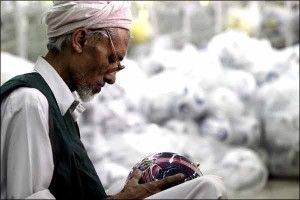
www.fairtrade.org.uk/sportsballs
FAIR TRADE SPORTS BALLS (UNHEP)
KS3 Citizenship – Fair Trade Video
Sialkot (Urdu: سیالکوٹ) is a city situated in the north-east of the Punjab province in Pakistan at the foothills of the snow-covered peaks of Kashmir near the Chenab river. It is the capital of Sialkot District and, formerly, it has been the winter-capital of the State of Kashmir. The city is about 125 km (78 mi) north-west of Lahore and only a few kilometres from Indian controlled Jammu. The recorded history of Sialkot covers thousands of years. Sialkot has, since its foundation, changed hands from Hindu, Buddhist, Persian, Greek, Afghan, Turk, Sikh and British rule to that of present-day Pakistan. Read More: > HERE <
Fair Trade is an organized social movement and market-based approach that aims to help producers in developing countries obtain better trading conditions and promote sustainability. The movement advocates the payment of a higher price to producers as well as social and environmental standards. It focuses in particular on exports from developing countries to developed countries, most notably handicrafts, coffee, cocoa, sugar, tea, bananas, honey, cotton, wine, fresh fruit, chocolate and flowers. Read More: > HERE <
An innovative company with history – SELECT Sport is one of the world’s leading manufacturers of hand-sewn balls and produces approx. 2 million balls a year. SELECT Sport is recognised as an innovator in quality balls and is represented by its own sales network or distributors in large parts of the world. We export to a total of more than 50 countries.
SELECT’s head office is located in Glostrup near Copenhagen. Our balls are produced in Pakistan by Anwar Khawaja Industries (AKI). We have never used child labour to produce our balls. SELECT’s workers and their families receive free medical assistance and medication through our SAHEP programme. This programme also provides education and schooling for all of the workers’ children.
A short look at how footballs are really made.
FIFA standard balls are hand-stitched in Pakistan for Fair Kick Soccer. In a size 5 ball, there are 690 stitches. As each of the five-sided pieces of polyurethane artificial leather are stitched to the others, the ball’s sphere gradually closes. The last stitches are done ‘blind’. That is, they use a pair of long needle-pullers, threading between stitches that they have already made, because they cannot get their hands inside the ball. At the same time, they have to be careful that they do not puncture the butyl air bladder inside. > http://de.fifa.com/<
LeadEarth – Environmental & Int. Development
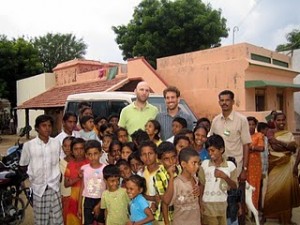
Jews, Christs & Muslims ~ Intercultural Dialog
Isralestinian Ghandis – Meditation for Peace
Israel (Hebrew: יÖ�שÖ�ׂרÖ�אÖ�ל, YisrÄ�’el; Arabic: إِسْرَائِيلُ, IsrÄ�’Ä�l), officially the State of Israel (Hebrew: About this sound מÖ�דÖ�ינÖ�ת יÖ�שÖ�ׂרÖ�אÖ�ל (help·info), MedÄ�nat YisrÄ�’el; Arabic: دَوْلَةُ إِسْرَائِيلَ, Dawlat IsrÄ�’Ä�l), is a country in Western Asia located on the eastern shore of the Mediterranean Sea. It borders Lebanon in the north, Syria in the northeast, Jordan and the West Bank in the east, the Gaza Strip and Egypt on the southwest, and contains geographically diverse features within its relatively small area. Israel is the world’s only predominantly Jewish state, with a population of 7.5 million people, of whom 5.7 million are Jewish. Arab citizens of Israel form the country’s second-largest ethnic group, which includes Muslims, Christians, Druze, and Samaritans.
The modern State of Israel has its historical and religious roots in the Biblical Land of Israel, also known as Zion, a concept central to Judaism since ancient times. Political Zionism took shape in the late-19th century and the Balfour Declaration of 1917 formalized British policy preferring the establishment of a Jewish state. Following World War I, the League of Nations granted Great Britain the Mandate for Palestine and the responsibility for establishing „the Jewish national home“ within it. Read More: > HERE <
Tamil Nadu (Tamil: தமிழ்நாடு „Country of the Tamils“, pronounced [t̪ɐmɨɻ n̪aːɽɯ]( listen)) is one of the 28 states of India. Its capital and largest city is Chennai (formerly known as Madras). Tamil Nadu lies in the southernmost part of the Indian Peninsula and is bordered by the States of Puducherry (Pondicherry), Kerala, Karnataka and Andhra Pradesh. It is bound by the Eastern Ghats in the north, the Nilgiri, the Anamalai Hills, and Palakkad on the west, by the Bay of Bengal in the east, the Gulf of Mannar, the Palk Strait in the south east, and by the Indian Ocean in the south. Read More: > HERE <
Leadearth is an 8 months leadership program of Environmental and Social projects in Israel and India. LeadEarth is an eight-month leadership program for young professionals who wish to gain experience in the fields of social action, community empowerment and environmental and international development.
The LeadEarth program was designed to foster social entrepreneurs in the fields of environmental sustainability and informal education and enable them to acquire the skills, knowledge and hands-on experience to initiate, develop and lead projects in their own communities and in developing countries.
LeadEarth offers professional training, personal growth, self empowerment and a unique opportunity to initiate, develop and lead community projects.
The LeadEarth program includes a five-month training program in Israel followed by three months of field work in India and a closing seminar to prepare participants for further professional work and studies.
During the first five months of the program, participants live on Kibbutz Ein Zivan, where you will study and volunteer. Here you will receive professional training in the fields of sustainable ecological development and project management.
In the second part of the program, volunteers will travel to the Tamil Nadu state of India where you will live in an international volunteer community and work with grassroots NGOs, including the Center for Culture and Development (CCD) and Sadhana Forest. These organizations, together with an Adam LeAdam professional team leader, guide the volunteers in the initiation, development and operation of community projects, while focusing on promoting environmental awareness through informal education.
As LeadEarth graduates, you will receive ongoing support to enable you to sustain social and environmental involvement and activities in India or in your home community.
As a participant of the program you will: Prepare for further studies and professional job opportunities in the fields of environmental studies, ecological sustainability, international development and project management. Gain knowledge of Israel and India through living and working with local communities. Work and train with the next generation of international, young, Jewish, social entrepreneurs. Receive professional training in sustainable living including: clean energy, building planning, composting, chemical-free products and organic farming. Undergo survivor training in order to learn to deal with uncertainty in outdoor conditions. Receive accreditation from leading NGOs in Israel and India.
- Meet Lead Earth friends, fans at fb <
- Meet Isralestinian Gandhis , friends, fans at fb <
- Meet United Israel Peace, friends, fans at fb <
- Meet M.K. Gandhi Institute for Nonviolence, studies, friends at fb <
- Council for a Parliament of the World’s Religions (CPWR)<
IYENGAR YOGA & SAVE GANGA MOVEMENT
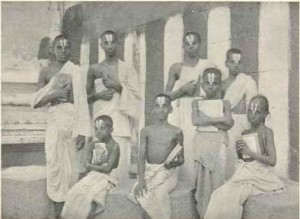
Iyengar Vedic Students 1909
The World’s First Sage Patanjali temple
„Health is firmness in body, stability in mind, and clarity in thinking. If a mirror is clean, it reflects objects clearly….health is the mirror of man.“ – B.K.S. Iyengar
Bellur Krishnamachar Sundararaja Iyengar (Kannada: ಬೆಳ್ಳೂರ್ ಕೃಷ್ಣಮಾಚಾರ್ ಸುಂದರರಾಜ ಐಯಂಗಾರ್, Tamil: பெல்லூர் கிருஷ்ணமாச்சார் சௌந்தரராஜா ஐயங்கார்), (generally known as Yogacharya B. K. S. Iyengar) (Born December 14, 1918 in Bellur, Kolar District, Karnataka, India) is the founder of Iyengar Yoga. He is considered one of the foremost yoga teachers in the world and has been practicing and teaching yoga for more than 75 years. He has written many books on yogic practice and philosophy, and is best known for his books Light on Yoga, Light on Pranayama, and Light on the Yoga Sutras of Patanjali. He has also written several definitive yoga texts. Iyengar yoga centers are located throughout the world, and it is believed that millions of students practice Iyengar Yoga.
He was awarded the Padma Shri in 1991, and the Padma Bhushan in 2002. In 2004, Iyengar was named one of the 100 most influential people in the world by Time Magazine. Read More: > HERE <
The Patanjala Yoga Kendra was established in 1993 on the banks of the Holy River Ganges in Rishikesh, the world capital of Yoga. The method of Yoga that is taught is Iyengar Yoga, as developed and taught by Shri Guruji, B.K.S. Iyengar, the world-famous Yoga Teacher. Guruji’s method is firmly based in the ancient Indian tradition of Yoga as defined in the Yoga Sutras of Patanjali. Usha Devi is the resident Yoga Instructor.
Iyengar Yoga teaches strength and stamina, flexibility and balance, concentration and meditation. Iyengar Yoga begins with physical awareness, but goes beyond to embrace emotional and spiritual growth. As students learn to extend consciousness to each part of their bodies, they experience a concentrated focus on the moment. In time, this concentrated focus (Pratyahara) becomes an integral part not just of a yoga practice, but of daily life.
Welcome to Save Ganga Movement – A Gandhian Non-violent Movement to Save the Ganga, symbolizing all rivers and water bodies and the Giriraj Himalayas, symbolizing all mountains, forests and wildlife. Gandhi symbolizes a culture of Truth and non-violence, i.e. a culture of pursuit of ethical perfection as the ultimate goal of life and pursuit of selfless ethical life of universal love as it’s means. The Surest and Perhaps the Only Solution to Our Impending Catastrophic Global Ecological Crises: Go Through Gandhi the Apostle of Truth and Non-violence of our Age.
- IYENGAR – BELLUR SCHOOL TRUST (BKSSNT)<
- Monasteries Environmental Himalayaprotection <
- SAVE MOTHER EARTH, SAVE GANGA & YAMUNA <
- Meet Iyengar Yoga, studies, friends, fans at fb <
- Meet Save Ganga Movement, friends at fb <
- Meet Save the Ganga (Ganges) River, friends at fb <
- Meet Save Yamuna to save Vrindavan! at fb <
- Meet M.K. Gandhi Institute for Nonviolence, studies, friends at fb <
KALA AZAR – Save One Life with One Dollar
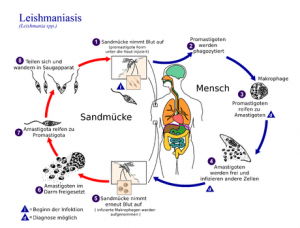
Doctors without Borders/kala azar
Nonprofits Work to Treat Rare Diseases too, – in Third World
KNOWLEDGE, ATTITUDE, AND PRACTICES ~ BHU
“ India is not a country of the Hindus only. It is a country of the Muslims, the Christians and the Parsees too. The country can gain strength and develop itself only when the people of the different communities in India live in mutual goodwill and harmony .It is my earnest hope and prayer that this centre of life and light which is coming into existence, will produce students who will not only be intellectually equal to the best of their fellow students in other parts of the world, but will also live a noble life, love their country and be loyal to the Supreme ruler. ~ Pandit Madan Mohan Malaviya“ ( > Information Maha Mana Pandit Folder < ) .
Leishmaniasis is a disease caused by protozoan parasites that belong to the genus Leishmania and is transmitted by the bite of certain species of sand fly (subfamily Phlebotominae). Although the majority of the literature mentions only one genus transmitting Leishmania to humans (Lutzomyia) in the Americas, a 2003 study by Galati suggested a new classification for the New World sand flies, elevating several subgenera to the genus level. Elsewhere in the world, the genus Phlebotomus is considered the vector of leishmaniasis. Read More: > HERE <
Visceral leishmaniasis (VL), also known as kala-azar, black fever, and Dumdum fever, is the most severe form of leishmaniasis. Leishmaniasis is a disease caused by protozoan parasites of the Leishmania genus. It is the second-largest parasitic killer in the world (after malaria), responsible for an estimated 500,000 cases each year worldwide. Read More: > HERE <
Largely unknown in the developed world, leishmaniasis is a tropical, parasitic disease caused by one of over 20 varieties of Leishmania and transmitted by bites from certain types of sandflies. The most severe form, visceral leishmaniasis, is also known as kala azar, Hindi for black fever. Over 90 per cent of cases occur in Bangladesh, Brazil, India, Nepal and Sudan. Without treatment, this form of leishmaniasis is fatal in almost 100 per cent of cases.
Kala azar attacks the immune system, causing fever, weight loss, anaemia and an enlarged spleen. There are considerable problems with existing diagnostic tests, which are either invasive or potentially dangerous and require lab facilities and specialists not readily available in resource-poor settings. Treatment requires painful, daily injections of drugs for 30 days.
The drug most widely used to treat kala azar, sodium stibogluconate (SSG) was developed in the 1930s, is relatively expensive and causes a toxic reaction in some patients.
> Blanket Distribution, Food Relief Camp <, www.foodrelief.org
KALA AZAR & AIDS MULTIPLY….. Co-infection of leishmaniasis and HIV is emerging as a growing threat, as both diseases attack and weaken the immune system. Infection with one of these diseases makes a person less resistant to the other and treatment becomes less effective. MSF through its Access to Essential Medicines campaign is urging for more research into suitable diagnostic techniques and affordable drugs to treat this neglected disease. Leishmaniasis (kala azar): > International Activity Report, 2007 <
Bericht zu meiner Perureise, Freundeskreises Peru Amazonico e.V. war dessen Gründungsmitglied Eugen Bruder (ehemaliger DED-Entwicklungshelfer in Peru) im Februar in Peru und besuchte die Projekte. Näheres auch im Internet unter www.peru-amazonico.de
Glucantime/Leishmaniose – Seit etwa 10 Jahren liefern wir das Medikament Glucantime gegen die tropische Krankheit Leishmaniose nach Peru. Damals waren wir von einer befreundeten Peruanerin aus Huanuco (östliches Andengebiet, Richtung Urwald) gebeten worden, dieses Medikament zu besorgen, da es in Peru knapp und teuer sei. Leishmaniose, in Afrika und Asien in seiner viszeralen (= innerkörperlichen) Form als „Kala Azar“ (= schwarzer Tod) bekannt, tritt in Mittel- und Südamerika als Erkrankung der Haut und Schleimhäute auf (kutane und mukokutane Form). Gefährlich ist vor allem die mukokutane Form, da dort die Schleimhäute von Nase, Mund und Rachen befallen werden und grässliche Verstümmelungen zur Folge haben können, weshalb die krankheit auch weiße Lepra ( „the white leprosis“ ) genannt wird.
Kala Azar: „A Disease of the Poorest of the Poor“
Drugs against Kala Azar costs in developed countries only 1 dollar, in third lands 10 dollars ( people their earn this in one month or year or none) , so found the Peru Rainforest Friends a efficient and cheap legal Drug Air Port Delievery Help to keep the friends in Peru healthy: – Wir haben eine sehr günstige und effektive Form des Medikamententransports nach Peru gefunden: Reisende, die nach ein paar Kilo „Luft“ im Gepäck haben, nehmen es freundlicherweise mit nach Peru. Ich hatte über 20 kg Glucantime dabei. Die 1.900 Ampullen gingen ohne Probleme durch den Zoll (ich hatte „grün“ an der Ampel). In Cusco wartete man dringend auf das Glucantime.
Ich hatte 1.400 Ampullen mitgenommen (die restlichen 500 Ampullen gingen nach Huanuco). Gerade als ich das Glucantime im Hospital Antonio Lorena übergeben hatte, kam ein 24-jähriger Mann mit einer offenen Wunde an jedem Arm. Bei ihm war gerade Leishmaniose diagnostiziert worden. Er kam aus dem Distrikt Acomayo und war ein paar Monate als Holzfäller (Wood Logger) im Urwaldgebiet Puerto Maldonado, wo er durch einen Mückenstich infiziert worden war. Zu Hause hat er einen kleinen Bauernhof, aber da das Geld nicht reicht, macht er diesen Holzfällerjob. Während früher die meisten Leishmaniosekranken sich als Goldwäscher infiziert hatten, sind es jetzt zunehmend Holzfäller (Wood Logger) . Die meisten können sich das Medikament nicht leisten. Eine Ampulle kostet in der Apotheke etwa 10 Dollar (während wir es hier für 1 Dollar kaufen – hier sieht man die menschenverachtende Preispolitik der Pharmamultis). Quelle: www.peru-amazonico.de
- www.thlib.org , www.visva-bharati.ac.in , www.aeinstein.org
- The International Centre of BHU <
- www.rainforestinfo.org.au
- DR. RUTH PFAU, MALC, DAHW <
- THE TIBETAN AND HIMALAYAN LIBRARY <
- ESTC 2010 Lead. Sustain. Engage. ECOTOURISM CONFERENCE 2010 <
- Bangladesh Top Prize 3rd Annual Photoshare Contest <
- Meet Doctors without Borders http://www.msf.org, studies, friends at fb <
- Meet The International Ecotourism Society (TIES), friends, fans at fb <
- Meet National Geographic, friends, fans at fb <
- Meet Global Concern, http://www.glcoin.org, studies, friends at fb <
- Meet Peace, Justice and Environment Project, http://www.pjep.org <
- Meet Coast to Coast, http://www.coasttocoastam.com/ friends fans & at fb <
- Meet Human Rights Watch, friends, fans at fb <
- Meet M.K. Gandhi Institute for Nonviolence, studies, friends at fb <
- Meet International Society of Hildegard von Bingen Studies at fb <
- Meet 100 Million Voices for a Real Climate Deal in Mexico 2010 at fb <
Sustainable Communities through Education
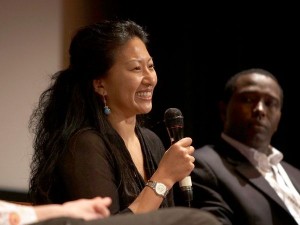
Kham (Tibetan: ཁམས; Wylie transliteration: Khams; Simplified Chinese: 康巴; Pinyin: KÄ�ngbÄ�), is a region presently divided between the Chinese provinces of the Tibetan Autonomous Region, and Sichuan where Khampas, a subgroup within the Tibetan ethnicity, live. It is also one of the three traditional provinces claimed by the Tibetan government-in-exile. Read More: > HERE <
Education and capacity-building form the core of the Machik mission. Learn how a ground-breaking school is helping revitalize a community in a rural Tibetan township.
Located deep in the heartland of Kham, Chungba was, until a few short years ago, a typical rural Tibetan community. With no electricity, running water, telephone, internal roads and virtually no literacy, this mountain community was unequipped to manage the rapid changes arriving at its door. Today, an investment in a primary school has stimulated a broad-based effort to revitalize the community while setting a new standard for rural Tibetan education across the prefecture.
We are deeply saddened by the recent earthquakes in Tibet. In the first four days after the earthquake we raised and sent $38,000 for relief aid. We hope you will let your family, friends and colleagues know that the Tibetan people of Jyekundo need our continued help.
Thank you and we look forward to staying in touch.
The Chungba School Story – Since it first opened its doors in 2002, the Ruth Walter Chungba Primary School has challenged regional stereotypes about the potential of rural Tibetan children. In its first year of operation, the students of Chungba achieved the highest results on county-wide standardized exams, despite being the first generation in Chungba ever to have access to formal education. Surprised by the results, county officials ran a second round of standardized exams for the Chungba school. And the tests results were even higher.
Today, with a residential community of 340 students and staff, the Chungba Primary School has become a model for rural education throughout the eighteen counties of the Ganzi Tibetan Autonomous Prefecture – a region of nearly a million Tibetans. New resources and creative programming have played a role in the success of the CPS projects that include an annual Chungba Summer Learning Program, a traditional Tibetan dance program, a library, an organic greenhouse and other green technologies to promote conservation and environmental consciousness. Watch an introductory video clip of the CPS. The Chungba Summer Learning Program in particular has offered the Chungba kids an array of resources to expand their knowledge of their world and to learn about new forms of knowledge production. These include learning about both traditional knowledge, such as Tibetan storytelling, as well as the use of new digital media.
These images of the Chungba Primary School from 2004-5 were edited by Tsering Perlo , documentarian and founder of Rabsal, an association of young Tibetans dedicated to the revitalization of Tibetan culture. // Pilgrimage Through Kham: A Medical Mission in Tibet
Born in a Tibetan refugee camp in India, raised in Canada, holding a Ph.D. from the University of London’s School of Oriental and African Studies (SOAS), Losang Rabgey has found her life’s work in remote Tibetan villages of farmers, seminomads, and nomads.
An anthropologist specializing in contemporary Tibetan culture and gender relations, Rabgey explains, „I believe that whatever kind of theoretical, research-based work you do, it must be grounded in local knowledge. It’s critical to have a hands-on understanding of what life looks like and feels like to the people you work with.“
- http://johnullman.multiply.com
- www.awamfoundation.org
- Khenchen Lama, AWAM Foundation, Khampas <
- Meet Lobsang Rabgey, friends, studies, fans at fb <
- Meet Survival International, friends, fans at fb <
- Meet Indigenous Peoples Issues and Resources, friends, fans at fb <
- Meet UN International Year of Biodiversity 2010, friends, fans at fb <
- Meet National Geographic, friends, fans at fb <
- Meet 100 Million Voices for a Real Climate Deal in Mexico 2010 at fb <
Mother´s Day- Flowers for Human Rights
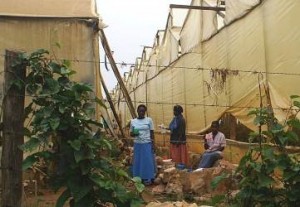
Green Shopping Guide Österreich: http://bewusstkaufen.at
NATIONAL GEOGRAPHIC – GREEN GUIDE
Lotus Flower – Symbol of Purity and Great Beauty!
The modern Mother’s Day is celebrated on various days in many parts of the world, most commonly in May, though also in March, as a day to honor mothers and motherhood. In the United States it was nationally recognized as a holiday in 1914 after a campaign by Anna Jarvis. In some countries, it follows the old traditions of Mothering Sunday. Read More: > HERE <
Mother’s Day (U.S.) is an annual holiday that recognizes mothers, motherhood and maternal bonds in general, as well the positive contributions that they make to society. In the United States, it is celebrated on the second Sunday in May. Read More: > HERE <
Flowers around the globe – Are you aware that the cut flower you buy in the supermarket or at your florist might have travelled thousands of kilometres to please you at home or in the office? Indeed, an increasing share of flowers which are sold in Europe is grown in countries close to the equator.
Do you wonder why? Around the equator conditions for growing flowers are more favourable than in Europe. Those countries don’t have cold winters, they constantly have 12 hours daylight and they have fertile soil. Labour is cheap and, labour and environmental laws are not as strict as in Europe, or at least, they are not enforced.
Are you concerned about the latter? We, too, are. That’s why we have started a campaign to raise awareness on labour rights, workers‘ health, and environmental protection in the flower industry. Join us and be part of the change.
The campaign „Fair Flowers for Human Rights“ – Non-governmental organisations from Austria, Belgium, Germany, and Czech Republic have jointly started a campaign to raise awareness on human rights violations and environmental pollution by the global flower industry. The campaign is supported by the Zimbabwean Non-Governmental Organisation Kunzwana and the Uganda Workers‘ Education Association.
The campaign targets consumers, flower traders and local authorities and it aims at changing their consumption and purchasing patterns towards ensuring that flowers are produced in socially and environmentally sound conditions.
As means to reach our targets we will produce information material, organise exhibitions and speakers‘ tours of flower workers, produce a movie, conduct workshops and lobby politicians. We will be present at various public events. You can read more on the specific actions in each country if you click on the logos of the campaign partners below. http://www.flowers-for-human-dignity.org/09/index.php/the-campaign.html
Fair trade roses for Mother´s Day & Human Rights
Da die heimische Schnittblumenproduktion die Nachfrage am österreichischen Markt nicht befriedigen kann, werden fast zwei Drittel der in Österreich verkauften Blumen aus Ländern des Südens importiert. Jährlich sind das zum Beispiel gut 80 Millionen Rosen. Auf den Blumenfarmen in Kenia, Uganda, Simbabwe, Ecuador und Kolumbien arbeiten zum Großteil Frauen, vielfach unter katastrophalen Arbeitsbedingungen.
Besonders vor dem Muttertag und den Valentinstag leisten sie Überstunden bis spät in die Nacht, oft werden diese nicht oder nicht vollständig bezahlt. Die Frauen berichten von gesundheitlichen Schäden aufgrund der Arbeit mit hoch giftigen Pestiziden und mangelndem Arbeitsschutz, auf manchen Farmen auch von sexueller Belästigung.
„Für die Frauen bedeutet die Arbeit auf den Blumenfarmen ein wichtiges Einkommen. Besonders in Lateinamerika arbeiten viele allein erziehende Mütter auf den Farmen. Sie benötigen dringend einen angemessenen Lohn, um sich und ihre Kinder adäquat ernähren zu können.“, berichtet Sophie Veßel, Koordinatorin der Kampagne „ Fair Flowers – mit Blumen für Menschenrechte “ bei der Menschenrechtsorganisation FIAN Österreich.
FIAN setzt sich seit vielen Jahren für die Rechte der ArbeiterInnen auf Schnittblumenfarmen weltweit ein. In Betrieben, die mit dem Gütesiegel Flower Label Program (FLP) zertifiziert wurden, werden Arbeits- und Menschenrechte eingehalten. Die Arbeitszeiten sind in langfristigen Verträgen geregelt, Überstunden werden angemessen bezahlt. Entsprechende Kleidung schützt die ArbeiterInnen vor den Chemikalien. Hoch giftige Pestizide dürfen überhaupt nicht eingesetzt werden. Für Frauen ist insbesondere wichtig, dass ihnen bezahlter Mutterschutzurlaub gewährt wird, sie während der Schwangerschaft geschont werden und sexuelle Belästigung nicht geduldet wird.
Daher empfehlen FIAN und die Volkshilfe Österreich, beim Blumenkauf zu Blumen der Gütesiegel Flower Label Program (FLP) und FAIRTRADE zu greifen. „Blumen, die unter fairen Arbeitsbedingungen produziert wurden, sind ein besonders sinnvolles Geschenk. Denn sie unterstützen den Kampf gegen Ausbeutung von ArbeiterInnen.“, meint Josef Weidenholzer, Präsident der Volkshilfe Österreich. „Mit dem Kauf solcher Blumen können Sie doppelte Freude schenken. Der eigenen Mutter und der Blumenarbeiterin.“ Dass die Blumen nicht mit hoch giftigen Pestizid en belastet sind, trägt sicher zusätzlich zur Freude der Beschenkten bei!
FLP-Blumen verschiedener Sorten finden Sie im ausgewählten österreichischen Fachhandel, FAIRTRADE-Rosen in Supermärkten und im Fachhandel.
- AFRICAN TRADITIONAL MEDICINE <
- Weitere Informationen:
- www.fian.at (FLP-HändlerInnenliste)
- www.volkshilfe.at
- www.flowers-for-human-dignity.org
- www.fairflowers.at (FLP-HändlerInnenliste)
- The New 2008 Constitution of Ecuador <
- Meet Human Rights Campain, friends at fb <
- Meet FAIR TRADE certificied, friends at fb <
- Meet Human Rights Watch, friends at fb <
- Meet National Geographic, Green Guide, friends, fans at fb <
PLAYING FOR CHANGE MUSIC & FOUNDATION
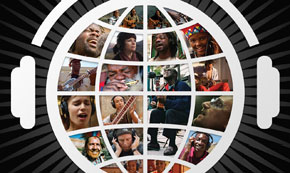
http://playingforchange.ning.com/
The Inspiration – Playing for Change is a multimedia movement created to inspire, connect, and bring peace to the world through music. The idea for this project arose from a common belief that music has the power to break down boundaries and overcome distances between people. No matter whether people come from different geographic, political, economic, spiritual or ideological backgrounds, music has the universal power to transcend and unite us as one human race. And with this truth firmly fixed in our minds, we set out to share it with the world.
The Production – We built a mobile recording studio, equipped with all the same equipment used in the best studios, and traveled to wherever the music took us. As technology changed, our power demands were downsized from golf cart batteries to car batteries, and finally to laptops. Similarly, the quality with which we were able to film and document the project was gradually upgraded from a variety of formats– each the best we could attain at the time—finally to full HD.
One thing that never changed throughout the process was our commitment to create an environment for the musicians in which they could create freely and that placed no barriers between them and those who would eventually experience their music. By leading with that energy and intent everywhere we traveled, we were freely given access to musicians and locations that are usually inaccessible. In this respect, the inspiration that originally set us on this path became a co-creator of the project along with us!
The Effect – Over the course of this project, we decided it was not enough for our crew just to record and share this music with the world; we wanted to create a way to give back to the musicians and their communities that had shared so much with us. And so in 2007 we created the Playing for Change Foundation, a separate 501(c)3 nonprofit corporation whose mission is to do just that. In early 2008, we established Timeless Media, a for-profit entity that funds and extends the work of Playing for Change. Later that year, Timeless Media entered into a joint venture with the Concord Music Group through the support of label co-owner and entertainment legend Norman Lear and Concord Music Group executive vice president of A&R John Burk. Our goal is to bring PFC’s music, videos and message to the widest possible audience.
Now, musicians from all over the world are brought together to perform benefit concerts that build music and art schools in communities that are in need of inspiration and hope. In addition to benefit concerts, the Playing for Change band also performs shows around the world. When audiences see and hear musicians who have traveled thousands of miles from their homes, united in purpose and chorus on one stage, everyone is touched by music’s unifying power.
And now, everyone can participate in this transformative experience by joining the Playing for Change Movement. People are hosting screenings, musicians are holding benefit concerts of every size, fans are spreading the message of Playing for Change through our media, and this is only the beginning. Together, we will connect the world through music!
> Playing for Change Utube Channel <
Playing for Change Foundation: Several years ago, a small group of filmmakers set out with a dream to make a documentary film about street musicians from around the world. That dream has grown not only into a reality, but into a global sensation called Playing For Change, and has touched the lives of millions of people.
While traveling to around the world to film and record these musicians, the crew became intimately involved with the music and people of each community they visited.
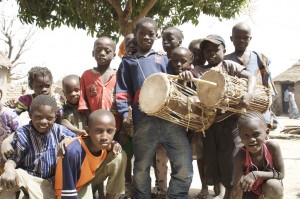
Many of these people lived very modestly in communities with limited resources; nevertheless, they were full of generosity, warmth, and above all they were connected to each other by a common thread: music.
In an effort to ensure that anyone with the desire to receive a music education would have the opportunity to do so, the Playing For Change Foundation was born.
The Playing For Change Foundation (PFCF) is dedicated to the fundamental idea that peace and change are possible through the universal language of music. www.playingforchange.org
CHRIST FELLOWSHIP MINISTRIES PAKISTAN
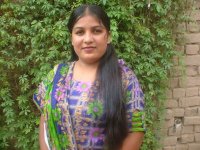
> CHRIST FELLOWSHIP PAKISTAN <
> Oxford Journal: Trad. Medicine in Pakistan <
> UNANI MEDICINE < > SIDDHA MEDICINE <
> UNANI Medicine with Reference to Pakistan and India <
Pakistan (Urdu: پاکِستان), officially the Islamic Republic of Pakistan, is a country in South Asia. It has a 1,046 kilometres (650 mi) coastline along the Arabian Sea and Gulf of Oman in the south and is bordered by Afghanistan and Iran in the west, India in the east and China in the far northeast. Tajikistan also lies very close to Pakistan but is separated by the narrow Wakhan Corridor. Thus, it occupies a crossroads position between South Asia, Central Asia and the Middle East.
The region forming modern Pakistan was at the heart of the ancient Indus Valley Civilisation and then later was the recipient of Vedic, Persian, Indo-Greek, Turco-Mongol, Islamic and Sikh cultures. The area has witnessed invasions and/or settlements by the Indo-Aryans, Persians, Greeks, Arabs, Turks, Afghans, Mongols and the British. Read More: > HERE <
Dear Friends in Christ, Greetings From Pakistan!
My name is Sabeeha Kiren. I am Finance Secretly and am working for Christian women, girls and widow in the Islamic Republic of Pakistan from the platform of Christ Fellowship Ministries, and am working for the Ministry as a sharing the Word of God with women, girls and widow how to pray and Praise Him, with them. We are Family of God.
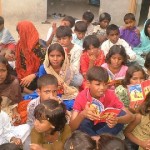
Christ Fellowship Ministries is working for the Christian Street Children who do not have support from the family because of poverty and those who are forced to child labor, begging, drugs, gambling and other criminal activities because of not being tended with love and care. The Christian people do not get equal rights as the Muslims possess. God bless you and keep you.
Yours Sister in Christ, Miss Sabeeha Saddique
Christ Fellowship Ministries
Khenchen Lama, AWAM Foundation, Khampas
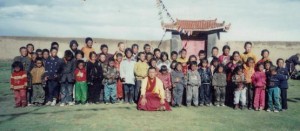
> Heart of Enlightment Institute <
www.upaya.org Zen Center Santa Fe, NM
http://khenchenlama.blogspot.com/
AWAM is a Sanskrit word for compassion coupled with wisdom. AWAM Foundation is a non-profit organization incorporated in the state of Arizona, established to provide support to an orphanage and elder center initiated by Khenchen Lama Rinpoche in eastern Tibet. The activities of the AWAM Foundation are guided by compassion and wisdom and aim to manifest and propagate these deepest values. The foundation aims to engage in fundraising projects that would provide basic needs, housing, medical care and education for the orphans and elders. Importantly, AWAM Foundation focuses on long-term projects directed towards future self-sufficiency of the orphanage and elder center. In our activities, we respect, encourage, and support the traditional Tibetan values. The foundation is governed by three volunteer board members following the guidance of Khenchen Lama Rinpoche. Please consider supporting the worthy activities of AWAM Foundation.
Kham (Tibetan: ཁམས; Wylie transliteration: Khams; Simplified Chinese: 康巴; Pinyin: KÄ�ngbÄ�), is a region presently divided between the Chinese provinces of the Tibetan Autonomous Region, and Sichuan where Khampas, a subgroup within the Tibetan ethnicity, live. Read More: > HERE <
In 1999, Khenchen Lama Rinpoche established an orphanage and a shelter for older people near Jewo monastery in Tibetan province Kham. At that point there were 30 children and 10 older people who did not have any family or government support to provide for them. Moved by their suffering, Khenchen Rinpoche decided to launch a project that would provide the basic needs of food and shelter for the orphans and elders and help them cultivate wisdom and compassion that would guide them to a better future. Arrangements were made for the children to receive basic general education, training in Tibetan and Chinese languages, as well as meditation. In addition, elders interested in meditation received practice instructions from Rinpoche and were supported in their desire to engage in deep meditation practice. Over the last nine years the orphanage and shelter for older people grew in size. Currently, there are 150 children, seven to eighteen years old, and 30 older people between sixty and eighty years of age. While the progress of children and elders in their study and meditation practice is encouraging, there is increasing need to provide for them. In response to Khenchen Rinpoche’s request and under his spiritual guidance, Rinpoche’s students in Arizona established the AWAM Foundation.
HEALTH CLINIC: Because of the secluded location of the orphanage and the elder center, access to medical care is very difficult. The closest hospital that can provide appropriate care is one-day drive from the orphanage. There is a great need for a small hospital, since swift access to medical care is a necessity for small children in the orphanage as well as the elderly. The health clinic would also serve lay Tibetans who inhabit the surrounding areas in proximity of the orphanage. The clinic is planned to include both treatments in traditional Tibetan medicine and Western medicine.
www.upaya.org Pilgrimage Through Kham: A Medical Mission in Tibet
DHARMA TARA YAK FARM – In an effort to make the orphanage and elder center more sustainable, Rinpoche and his students developed a project aimed at providing long-term food contribution to the orphanage through an orphanage-owned yak farm. The Dharma Tara Yak Farm is managed free of charge by a local businessman in Tibet and is providing the orphans and elders with dairy products – the main part of diet in Tibet. Yaks purchased for the orphanage and elder center will never be killed for meat. Between 50-70 yaks are needed to provide for the 180 orphans and elders. Any excess dairy products will be in the future sold for purchase of other food articles for the orphanage. Khenchen Rinpoche is very hopeful about this project because it will provide for the orphans and elders as well as help sustain the traditional way of care for yaks. With recent changes in Tibet, increasing numbers of yaks are being raised for meat and slaughtered in a cruel way.
To launch the project, one of Khenchen Rinpoche’s students donated funds for the first 15 yaks in May 2008. Funds for additional 5 yaks were donated by Rinpoche’s Chinese students. Most recently, Rinpoche’s students from the Dharmakirti College in the USA made a donation for purchase of additional 5 yaks. The herd has currently 32 yaks because 7 baby yaks have been born since May 2008 and this number will grow every year (see picture below). We are very grateful to those who contributed to this project so far! Thanks to your support the start of the project has been a great success!
EDUCATION – When Khenchen Lama Rinpoche started the orphanage, one of the main priorities was to make sure that orphans receive the best education available in the area. To this aim, arrangements were made to cover the basic educational needs for the orphanage. Currently, there are four teachers: 2 monks from a near monastery and 2 local teachers. The curriculum focuses on reading and writing in Tibetan language, Tibetan history and culture, basic algebra, and Chinese language.
Jabulani – a self help project in Mariannhill
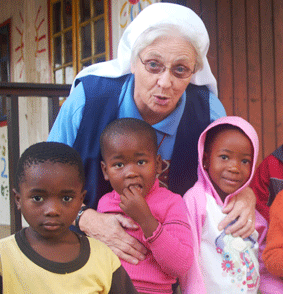
Jabulani (IsiZulu) „Be Happy“
http://www.jabulani-centre.org/
http://jabulaniafrika.blogspot.com/
The greatest good we do to others is not to give them our own wealth but to show them their own. – ( Kardinal Suenese)
The Origins of Jabulani – Jabulani opened officially on the 4th of January 1988. At that time many people came to Mariannhill Mission for help after becoming homeless in the heavy floods in 1987. However, it was impossible to reach the poorest people. Thus the Sisters of the Precious Blood decided to open a centre for those affected.
Sr. Marco Gneis agreed to establish the project together with Mrs. Audrey. Prior to founding Jabulani the two nurses had been teaching mothers coming to St. Mary’s Hospital how to grow vegetables at home in an attempt to combat malnutrition, visiting different areas within a wide radius of the hospital with a mobile clinic.
> spiritreneuringrid’s Channel <
The Jabulani School Report – In the early days of Jabulani many people had to flee their homes and seek new shelter. This caused many problems, especially for the children involved. The local schools were overcrowded so that some of these children were refused admission. The arguments used revolved around the bad influence these children from allegedly criminal areas would have on the other pupils. The outcome was that a large number of children could not go to school that particular year. So Bhekani Mzobe started to teach the children of different grades at Jabulani.
Who comes to Jabulani every day? – About 140 women and 15 men from the surrounding townships are working at Jabulani. These people cannot find work on the open job market because they lack education or qualifications or because their family situation does not allow it. At Jabulani they have the chance to earn a small salary with which they can feed their families and offer their children a better future. The day starts at 7.30 am and ends around 3.30 pm, teatime and lunchtime included.
Jabulani Projects – Many projects in Jabulani were established within a very short space of time, including the gardening, sewing, embroidery, candle-making, bakery and weaving projects. Unfortunately some of these projects had to be stopped in the course of time due to the economic situation. The sewing project was restarted again later when it was decided to sew clothes for the Jabulani people themselves. Thus school uniforms, cushion covers, children’s clothes were made in addition to products for tourists.
Jabulani and Religion – In Jabulani one finds Catholic symbols alongside Zionist symbols, demonstrating that Jabulani is open for everyone, whether Christian, Zionist or Muslim. In Jabulani the different cultures and religions exist not only alongside one another, but also together with one another. And in the little meditation room all groups can practice their faith.
African Traditional Medicine, Ethnomedicine
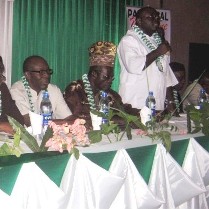
> WHO – Traditional Medicine <
”Health through cultural heritage“
Traditional medicine (also known as indigenous or folk medicine) comprises medical knowledge systems that developed over generations within various societies before the era of modern medicine. Practices known as traditional medicines include herbal, Ayurveda, Siddha medicine, Unani, ancient Iranian medicine, Islamic medicine, traditional Chinese medicine, acupuncture, Muti, Ifá, and other medical knowledge and practices all over the globe. The World Health Organization (WHO) defines traditional medicine as: „the health practices, approaches, knowledge and beliefs incorporating plant, animal and mineral-based medicines, spiritual therapies, manual techniques and exercises, applied singularly or in combination to treat, diagnose and prevent illnesses or maintain well-being.“
In some Asian and African countries, up to 80% of the population relies on traditional medicine for their primary health care needs. When adopted outside of its traditional culture, traditional medicine is often called complementary and alternative medicine. Herbal medicines can be very lucrative, generating billions of dollars in sales, but adulteration or counterfeit herbs can also be a health hazard. Read More: > HERE <
HISTORY OF TRADITIONAL MEDICINE – African Traditional Medicine is a mainstay of primary health care for the majority in Africa. About 80% of the population has relied on resources within their environment to survive since God’s creation.
Plants, minerals and animals constitute the major natural resources ever used by mankind for preventative, curative and rehabilitative health in Africa. Like any other continent, these resources have been used for over ten thousand years by traditional health practitioners (THP’s), who acquired their knowledge and skills through observation, spiritual revelation, personal experience, training and direct information from their predecessors.
THE ROLE OF EMERGED SCIENTIFIC TRADITIONAL MEDICINE SYSTEM: “ ETHNOMEDICINE “ – What is Ethnomedicine Science? Ethnomedicine is a multi-disciplinary field of study that draws on approaches and methods from both the social and biological sciences, culturally based biological and environmental knowledge, cultural perception and cognition of the natural world, associated behaviours and practices, concerned with the cultural interpretations of health, disease and illness, and also addresses the health care seeking process and healing practices.It is a study of cultural concepts of health, disease and illness, and of the nature of healing systems.
Ethnomedicine has turned it’s attention to laboratory research, which has been made possible by the auspices of the World Health Organisation (WHO). In fact, the traditional medicine programme of the WHO was precisely thought of as an answer to renewed interest for population therapies and remedies, in view of possible identification and utilisation within national health services.
African Medicine – the mother of medicines:
„If we accept that Africa is the cradle of mankind and that the use of herbs is as old as mankind itself, it then stands to reason that African medicine is the oldest, most tried and tested form of medicine known to mankind. Further, to call it an alternative is wrong, since it formed the basis for other types of medicine practiced today – conventional, herbal, Chinese, etc.“ T/Dr R de Carvalho.
History and Description – Ethnomedicine is a system that applies both art and science to help the human body to restore its health and well-being. It utilises natural remedies to activate the immune system. Herbs are used for cleansing, elimination and detoxification. Some are used to stimulate the body’s self-healing capabilities to counteract physical symptoms, whilst others may be used as a tonic to help the body’s immunity.
-
Vision – To manufacture and distribute an effective range of African herbal remedies and medicinal products that not only competes, but surpass its competitors.
-
To enhance and preserve the knowledge and wisdom of African herbal medicine.
-
To be a leader in the research and development of African herbal remedies and products.
PAXHERBAL, MAGAZINE: The aim of Pax Herbal Magazine is to re-assimilate, re-understand and re-express ancient African philosophy [indigenous knowledge] in light of modern, scientific knowledge [exogenous knowledge]. African Medicine, that is, the science of life, is at the centre of African philosophy. Life, for the African, is indeed the ultimate value. By exploring the multi-faceted dynamism of healing in Africa, Pax Herbal Magazine is championing a medical revolution that is all-embracing, holistic, African and global.
The Science – After years of repudiating ancient wisdom, science is now validating the wisdom of the ancients. Discoveries in quantum physics, radiology and electromagnetic force have changed the way scientists look at the world.
Pax Herbal products are currently a high-flying brand because they are efficacious, affordable and available. Recently, though, the monks of St. Benedict Monastery, Ewu, Esan, Edo State, the custodians of Africa’s most sophisticated, scientific and full-blown herbal pharmaceutical industry and their dedicated staff have been bending over backwards to meet a snowballing demand for their products.
-
www.epasa.co.za/ – Ethnomedicine Practicioners Ass. Africa
SMILE AFRICA FOUNDATION ~ E-WASTE

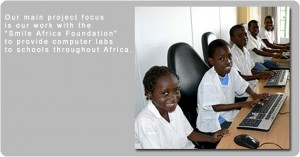
www.treesforlife.org cradle to cradle design
www.computerrecyclingsociety.org
Electronic waste, e-waste, e-scrap, or Waste Electrical and Electronic Equipment (WEEE) describes loosely discarded, surplus, obsolete, broken, electrical or electronic devices. The processing of electronic waste in developing countries causes serious health and pollution problems because electronic equipment contains some very serious contaminants such as lead, cadmium, beryllium and brominated flame retardants. Even in developed countries recycling and disposal of e-waste involves significant risk to workers and communities and great care must be taken to avoid unsafe exposure in recycling operations and leaching of material such as heavy metals from landfills and incinerator ashes. Read More: > HERE <
About CRSC – What is the Computer Recycling Society of Canada? – CRSC is a non-profit, community minded organization whose vision is to promote computer literacy for all people with emphasis on helping other charitable and non-profit groups. We provide affordable, refurbished computers and training programs to needful individuals and organizations locally and worldwide. Our main project focus is our work with the „Smile Africa Foundation“ to provide computer labs to schools throughout Africa. www.smileafrica.org
Who is involved? – Corporations, government and individuals all donate used computer equipment to our Society. Experienced computer technicians and educators in computer fundamentals, with the generous assistance of community volunteers, operate our facilities and run our programs.
Why is the Computer Recycling Society Necessary? – To fill a gap in computer education and to make computers available to people of all ages, across all income groups, through the auspices of other established, non-profit community organizations in your community and in developing countries.
WHERE can you make a difference? – If you have any computers or parts no longer useful to you or your company, we will refurbish and redistribute them to local and international communities through charitable organizations.
How can you Help? – We are always looking for people willing to volunteer their time and talents; repairing and teaching; picking up and delivering. All that’s required is enthusiasm and a desire to learn and help others.
SMILE AFRICA’s vision is based on three core principles: Literacy, Learning and Leadership; enabling partner communities (in Africa) to improve their human factor capacity for change, and to build a world fashioned more equitably.
2009 -2015 priorities include providing books, libraries and resources to foster quality education and help children and families refine and unfold their potential as leaders, thinkers and contributors of society.
beCAUSE™ 2015 Campaign – SMILE AFRICA’s beCAUSE™ campaign focuses on three achievable goals of the Millennium Development Goals (MDGs). If each one of us can play a small role along with leading organizations and world governments, we can combat illiteracy and poverty, and bring change to a significant portion of the human family.
Achievable Goals:
- Our MDGs Priorities by 2015:
- Provide one million books to help school children achieve literacy, and build libraries and schools in partnership with their communities.
- Improve the living conditions of vulnerable populations, e.g., via training and access to clean water and basic sanitation.
- Empower women via leadership and economic development; giving them resources to prevent poverty-related risks such as: hunger, infant illnesses and mortality. Read more…www.smileafrica.com
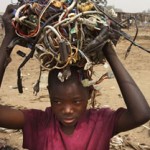
“ e-waste boy in africa „
-
TREE´s FOR LIFE: Computers to Empower People, gifts from the heart <
Reb Zalman Legacy Project, Migdal Ohr
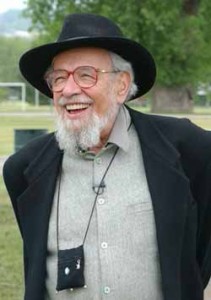
> What is authentic Judaism ? <
The Reb Zalman Legacy Project is a collaborative effort of the Yesod Foundation and Naropa University to preserve, develop and disseminate the teachings of Rabbi Zalman Schachter-Shalomi, better known as „Reb Zalman,“ an innovative leader in ecumenical dialogue and founder of the Jewish Renewal and Spiritual Eldering movements.
To this end, we hope to develop a unique on-line educational tool, giving users access to a virtual library of profound dimensions; a physical archival collection housed at Naropa University, providing a beautiful space for study, contemplation, and spiritual fellowship; a Contemplative Judaism M.A. program based on Reb Zalman’s teachings at Naropa University; ecumenical, spiritual direction, and eldering workshops; and new books, booklets, CDs, and DVDs, developed from the wealth of Reb Zalman’s material archive.
Important areas of intellectual and spiritual development to us are Deep Ecumenism (inter-religious dialogue), Paradigm Shift, Contemplative Practices, Ecology and Gaian Awareness, Spiritual Eldering, Psychology of Religion, Transpersonal Sociology, Jewish Mysticism, Hasidism, Jewish Renewal, Storytelling, and Sacred Music.
The Reb Zalman Legacy Project is a container that supports the evolving understanding of all of these ideas with the teachings of Reb Zalman as its core and foundation. We intend to preserve not only Reb Zalman’s body of work, but also his process of renewal, so that his teachings will not become calcified and exist with meaning primarily for our generation alone. Therefore, with an eye to the future, we are building open access-pathways to primary texts, inviting new commentary, and providing new possibilities for spiritual fellowship. „To Preserve, Develop, and Disseminate“
Reb Zalman Schachter-Shalomi: Healing the Planet, Rabbi Grossman for underprivilged children
Zalman Schachter-Shalomi, better known as „Reb Zalman,“ was born in Zholkiew, Poland, in 1924. Raised largely in Vienna, his family was forced to flee the Nazi oppression in 1938. After almost three years without roots, they finally landed in New York City in 1941, settling in Brooklyn, where young Zalman enrolled in the yeshiva of the Lubavitcher Hasidim. He was ordained by Lubavitch in 1947. He later received his Master of Arts degree in the Psychology of Religion in 1956 from Boston University and a Doctor of Hebrew Letters degree from Hebrew Union College in 1968.
He taught at the University of Manitoba, Canada, from 1956 to 1975 and was Professor of Jewish Mysticism and Psychology of Religion at Temple University until his early retirement in 1987, when he was named professor emeritus. In 1995, he accepted the World Wisdom Chair at Naropa University in Boulder, Colorado, officially retiring from that post in 2004.
Throughout his long career, Reb Zalman has been an unending resource for the world religious community. He is the father of the Jewish Renewal and Spiritual Eldering movements, an active teacher of Hasidism and Jewish Mysticism, and a participant in ecumenical dialogues throughout the world, including the widely influential dialogue with the Dalai Lama, documented in the book, The Jew in the Lotus.
One of the world’s foremost authorities on Hasidism, he is the author of the new book, A Heart Afire: Stories and Teachings of the Early Hasidic Masters (co-authored by Netanel Miles-Yepez), and on Jewish law, he has written, Integral Halachah: Transcending and Including (with Daniel Siegel). Reb Zalman currently lives in Boulder, Colorado, and continues to be active in mentoring his many students the world over.
For a complete biography and chronology of Reb Zalman’s life, please visit our „Life“ page. To see a complete list of Reb Zalman’s published works, see our „Works“ page.
Rabbi Yitzchak Dovid Grossman is a sixth generation Jerusalemite, born in 1946. A dramatic turning point in his life occurred in 1968 when he decided to move to the Lower Galilee town of Migdal Ha’Emek to provide the socio-humanitarian aid sorely needed there.
Migdal Ha’Emek had been established in 1953 as a development town designed to accommodate part of the great influx of Jewish immigrants from the North African countries. The town’s population grew in size much faster than the evolving socio-economic and educational infrastructure. The resulting shortage of jobs and lack of sufficient school facilities and teachers had a devastating effect on the inhabitants. Migdal Ha’Emek quickly became known as one of the prime centers of criminal activity in Israel.
Rabbi Grossman’s arrival on the scene was without fanfare. He had no welcoming committee and no mandate from the people or from the administration. Furthermore, he had no budget nor staff or even an office. He joined in the conversations of idle youth hanging out on the street corners and, after gaining their confidence, began organizing private classes for them. But he knew that to get to the core of the problem, he would have to tackle it at it’s roots.
Rabbi Grossman became a steady and frequent visitor at the town’s discotheques and pubs, engaging the young clientele in dialogues. Slowly but surely the tough exteriors began to peel away and there began to surface the gentle side of the members of the new generation searching for their true identity.
Migdal Ohr (Hebrew for „Tower of Light“) was established in 1972 for the express purpose of providing education and social guidance to the children from underprivileged and troubled homes ifrom across Israel. Overcrowded apartments, one-parent families, homes with drug problems, impoverished, crime-ridden families–these are the target populations from which Migdal Ohr draws its over 6,000 pupils at all levels of the educational spectrum. Its goal – to transform these students into proud and productive citizens of Israel.
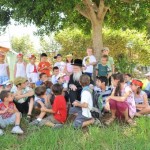
Migdal Ohr, Israel’s largest youth village, provides a nurturing home and outstanding education to over 6,500 orphaned, impoverished, underprivileged and new immigrant children. At Migdal Ohr, the children’s individual needs are met with love, warmth and tremendous sensitivity.
The Young Leadership Committee is dedicated to upholding the values and promoting the mission of Migdal Ohr. By developing creative programming, the Committee attracts young Jewish professionals, educates them about our mission, and encourages increased involvement.
The Young Leadership Committee is open to everyone interested in generating awareness for Migdal Ohr and affecting change in the lives of others. Our dynamic members come from varied backgrounds, and offer a broad range of perspectives and experiences. Together we plan and attend fundraisers and social events, meet hundreds of young adults in the New York area, and, best of all, help save children in Israel.
MIGDAL OHR EDUCATIONAL CENTER – The following is a brief description of some of the educational and social facilities provided by Migdal Ohr:
-
(a) Day Care Centers which provide tender, loving care to infants aged three months to three years old. These facilities offer the mothers of large families the opportunity to work and help their husbands support their children.
-
(b) Kindergartens, where pre-school age children get a proper start on the educational path.
-
(c) Primary and Secondary school systems, for boys and for girls, with full dormitory facilities, laboratories, computer centers, libraries, and youth centers, where emphasis is placed on individual attention to the child’s needs.
-
(d) Teachers‘ Seminary for single and married men, to develop the rabbis, educators, school administrators and rabbinical court judges required by Israeli society.
-
(e) Prisoner rehabilitation programs in Israel’s prisons. The recidivism rate among the „graduates“ of Migdal Ohr’s rehabilitation activities stands at about 10%, a sharp contrast to the 90% in the general prison population.
-
(f) Occupational Training Center offering adult education courses responsive to the requirements of government and industry for off-campus residents of northern Israel. Courses fall into three categories:
-
(I) OCCUPATIONAL DIPLOMA COURSES
-
(II) EDUCATION EXTENSION COURSES
-
(III) COMMUNITY ACTIVITIES
Act4Tibet – Yogi Tsoru Dechen Foundation

Yogi Tsoru Dechen Foundation, Florida
The Yogi Tsoru Dechen Rinpoche Foundation was created to provide Westerners access to the Buddha Dharma (Path of Awakening), and to supply Compassion and Wisdom to all human beings. The founder and spiritual leader of YTDR Foundation is Tulku Karma Gyurme Sonam Rinpoche, who is recognized as a Lama – a term reserved for senior members of the Tibetan Order.
ACT is a branch of the Yogi Tsoru Dechen Rinpoche foundation that is dedicated to helping the young Tibetan refugees and monks at Lama Tulku Karma’s camp in Mainpat, India.
Acupuncturists from Sedona treat Tibetans living in exile in a Tibetan refugee camp in India, called Mainpat. Invited by buddhist lama Tulku Karma Rinpoche, the experience so moved them that they formed the Tibetans in Exile Health Project, a not for profit tax exempt organization committed to meeting the health care needs of Tibetans living in exile.
YTDR manages several charitable programs which directly benefit the people of Tibet and help ensure the survival of their culture. The Foundation’s ultimate vision is to have Dharma Centers established throughout the world devoted to cultivating wisdom and compassion for all beings.
With Dharma Centers already established in Nepal and the US, these additional centers will sustain the teachings and unique lineage of Tibetan Buddhism that was nearly extinguished in the political upheavals of the 20th century, and which have been re-established while still in exile.
YTDR Foundation is a volunteer based organization, and is a registered Florida Charitable Entity EIN 30-0458849 that has applied for Federal Non-Profit Status.
Meet YTDR Sedona Dharma Center, friends, fans at fb <
Meet Act4Tibet, friends, fans at fb <
Architecture for Tibet – Manushree Orphanage
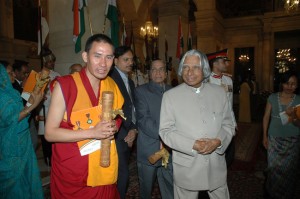
The PRESIDENT and Dalai Lama coming out after the Investiture Ceremony at> Rashtrapati Bavan<
> MANUSHREE VIDYAPITH ORPHANAGE <
> ARCHITECTURE FOR TIBET´s BLOG <
> KLIMA, ENERGIE, WOHNEN MIT UMWELTBERATUNG WIEN <
Architecture in Tibet contains Chinese and Indian influences, and reflects a deeply Buddhist approach. The Buddhist Prayer wheel, along with two deer or dragons, can be seen on nearly every Gompa in Tibet. The design of the Tibetan Chörtens can vary, from roundish walls in Kham to squarish, four-sided walls in Ladakh.
The most unusual feature of Tibetan architecture is that many of the houses and monasteries are built on elevated, sunny sites facing the south, and are often made out a mixture of rocks, wood, cement and earth. Little fuel is available for heat or lighting, so flat roofs are built to conserve heat, and multiple windows are constructed to let in sunlight. Walls are usually sloped inwards at 10 degrees as a precaution against frequent earthquakes in the mountainous area. Read More: >HERE <
INTRODUCTION – The Manjushree Orphanage free Education is one of the major projects in Arunachal Pradesh, Eastern part of Himalayan region. Whose purpose is to promote love, kindness, compassion and peace for the benefit of individuals, families, communities and the world? It will contribute to this endeavour by inspiring young people to act with a ‚good heart‘, to become leaders in their communities and to help bring peace into the world.
The name of the orphanage is called Manjushree Vidyapith, Orphanage. This orphanage was commence on 30th, October 1998 with an obvious and distinct intention of serving the deprived and disadvantaged children of the society irrespective of religion, caste, community, tribe, gender etc.
We started with 17 orphans with three teaching staffs from far-flung villages of this area in the year 1998. It is the first orphanage of its kind in whole area.
> Architecture for Tibet utube Channel <
In the beginning, one building was constructed to accommodate 17 orphans and 3 teaching staff. Army authority of the area had come forward to help the orphanage. Since then the number of orphans and destitute grow in geometric progression and the income of the orphanage in arithmetic progression. As a result, we are unable to admit many helpless orphans and neglected children.
The children who have lost their parents, the children who are destitute and dependent, and the children who have been born disabled or become disabled due to accident make up the family members of this orphanage.
Where they are provided with all the necessities of lives along with proper education and appropriate guidance to make them competent for facing various confrontations of lives.
At present, the orphanage is home to 108 children 80 orphans, 18 destitute and 10 physical disabled children from different social background. However, most of the children hail from this remote region. After coming here, they have started to relive their lives leaving their horrifying and disappointing past behind and they have begun to learn to tread forward with confidence and dignity. They live here as a different member of a single family, where every one is treated on equal terms.
We run a school inside our orphanage up to 5th grades. In the school, students are taught different subjects such as English, Math, Hindi, Tibetan, Science, Social Studies etc. 8 qualified teachers are engaged in imparting education to the orphans. Those who pass the 5th grade go to other school as day scholars but stay in the orphanage. Right now 25 students go to other school from our orphanage.
Besides, the residents are provided modern education, and equipped with moral values to help them become a better human being. The mental and physical growths of the residents and to help them possess a kind heart are given paramount importance. The orphanage has left no stone unturned to return back the smile they had lost.
So in all, the orphanage in itself has learnt to exist as very well knit family enriched with love, peace and knowledge and tranquility despite of many ups and downs. But in a way Manjushree family and I are indeed very thankful to all those great people who have been supporting us in one way or other without whose contributions we would not have reached this far. Read More: > HERE <
Our Project: Architecture for Tibet’s current project is an Academic Center for the Manjushree Orphanage in Tawang, Arucnachal Pradesh, in the high Himalaya of Northeast India. The new, light-filled Academic Center will replace the present schoolhouse, which is falling apart and not large enough to accommodate the number of children.
The proposed two-story building will contain not only classrooms, but a library, a multi-purpose space, a computer and language lab, and a large Nursery Environment, for the youngest children to learn, play and be cared for in. Within this place, the children can cultivate a true sense of friendship while gaining the knowledge they need to overcome their difficult circumstances.
The building is “green”: Temperature is regulated through a combination of geothermal and solar-based technologies, creating a warm environment during the harsh winters and a dry, airy place in summer, when the region receives heavy rains. This will enable the children to be comfortable, healthy, and active within their learning environment throughout all the seasons.
Our Organization: Architecture for Tibet has been founded by the Architectural Designer John Ullman of NYC and is composed of concerned professionals from the fields of architecture, engineering and education from around the world who are bound together by the common will to improve the built learning environ in Tawang, Arucnachal Pradesh.
- GREEN IDEAS DEIN IN DEIN AYURVEDA NET ARTICLE <
- Meet Tibet Friends, Culture, Arts, Medicine at facebook <
- Meet Himalaya Friends, Studies, Culture at facebook <
- Meet Green Architecture Groups and Studies at facebook <
- Meet Klimabündnis, KlimaschutzexpertInnen at facebook <
- Meet Architecture for Tibet, friends, fans at fb <